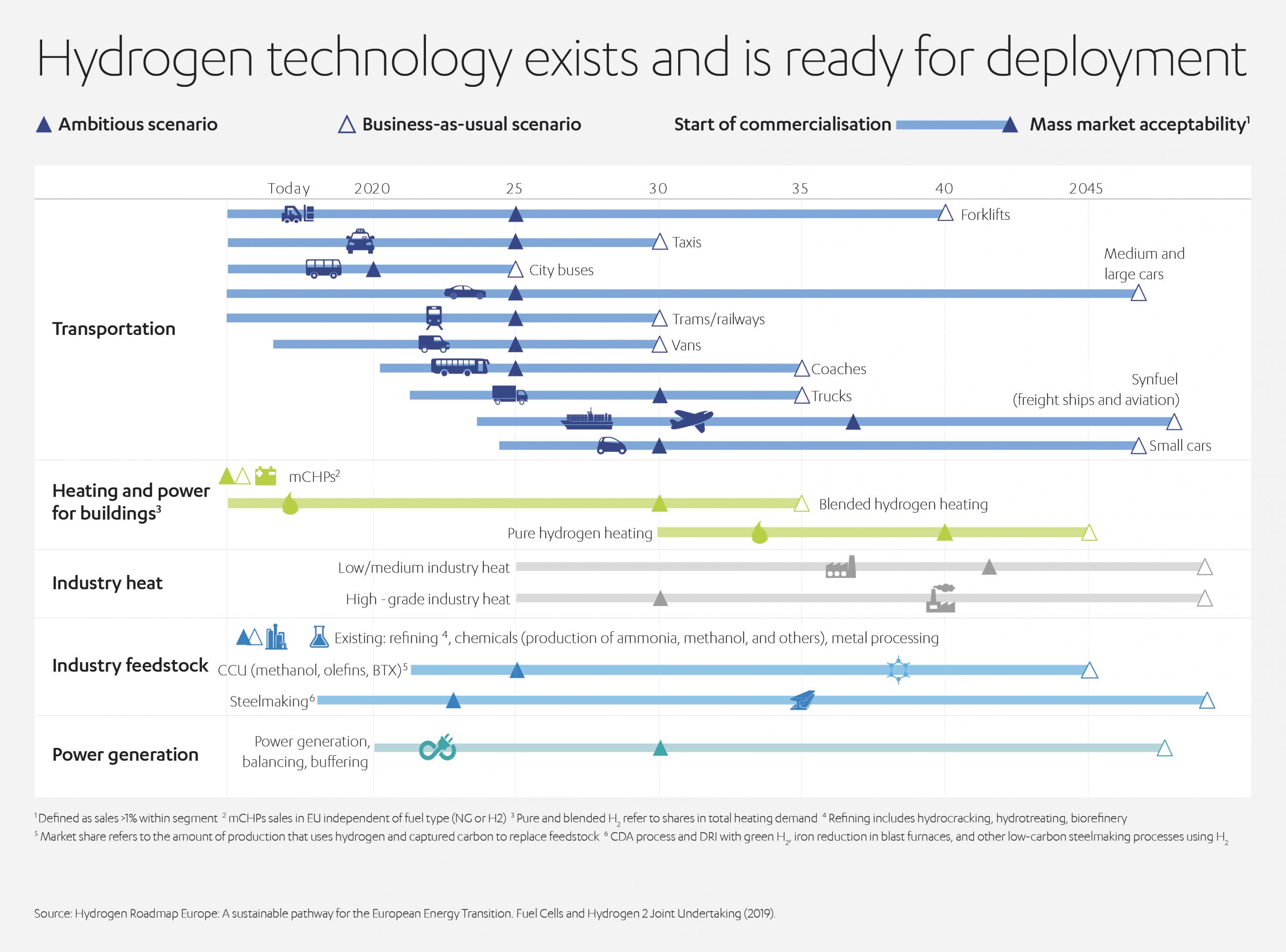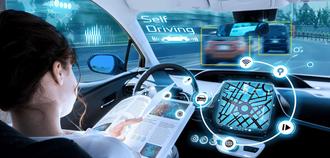Next stop: hydrogen-powered public transport

How the universe’s favorite element could become the go-to energy source for public mobility
If we’re going to put the brakes on global warming, the way we power vehicles has to change – not just private cars with their intermittent usage, but the vehicles of mass public transport that are driving around our cities all day, every day.
Transportation accounts for 24% of global CO2 emissions from fuel combustion, of which three quarters is road traffic.[1] The EU alone needs to eliminate 72% of the CO2 from its transportation fleet by 2050, to achieve the 2˚C (or less) scenario of the Paris Agreement targets.[2]

Electrification is often seen as the obvious answer—but is it always the best? In previous articles, we’ve championed the potential of hydrogen to revolutionize green energy and drive zero-emission transport. Here we focus on one of the most promising applications for this underused energy source: hydrogen-powered public transport.
What makes hydrogen ideal for public transport?
Hydrogen is an established, versatile, and easy-to-produce energy source. It also has numerous advantages which make it well-suited for larger vehicles, from buses to trains.
Fuel Cell Electric Vehicles (FCEVs) running on hydrogen produced, for example, emit 45% fewer emissions than vehicles with internal combustion engines.[3]

Hydrogen is also far cleaner on the roads. Biofuels, compressed or liquified natural gas (CNG/LNG), and hybrids all emit unwanted gases which impact local air quality.[4] Hydrogen just emits water vapor.[5]
Even more compelling is that fact that when created using renewable energy sources, so-called ‘green hydrogen’ can be a virtually CO2-free power source from production to operation. Battery-powered electric vehicles (BEVs) can achieve this in theory, but always depend on the energy mix where they are charged. Furthermore, hydrogen fuel cells are less energy-intensive to produce than batteries and require significantly fewer materials.

Longer ranges, higher payloads
The extended ranges achievable with hydrogen-powered vehicles is where they really come into their own, particularly for public transport. Hydrogen has a much higher energy density than batteries, both in volume and mass (or weight). The typical range of a hydrogen car is 700km–800km, compared to just 300km-400km in the very best performing electric vehicles.[6] FCEVs are therefore well suited for larger vehicles and those traveling long distances. Hydrogen buses can currently drive 150% further than electric vehicles (500km versus 200km).[7] This helps to account for hydrogen’s popularity in China, for example, where long-distance buses outnumber inner-city buses five to one.

Faster refueling; more convenient storage
Modern FCEVs recharge 10–15 times faster than electric vehicles.[8] And, fuel cell electric buses do not require any additional city infrastructure work or permits other than a centralized hydrogen refueling station (HRS) at the bus depot.[9] Hydrogen can also help balance the grid and store large amounts of energy for use later; fast electric vehicle (EV) chargers simply add peak demand.
On track to replace diesel trains
Hydrogen has the energy density to decarbonize trains while eliminating emissions and reducing noise. Electrification remains the preferred option, but track upgrades are often slower and more expensive than converting to hydrogen. Pilots are underway in Germany, and further projects have been announced in Austria and France.[10]
Even greener – even cleaner
However, although it may be the most abundant element in the universe, there remain significant hurdles to realizing hydrogen’s potential to decarbonize public transport.
While hydrogen itself is incredibly clean and emissions-free, the process to produce it is rarely so sustainable, as outlined in our Abdul Latif Jameel Perspectives article on green hydrogen. Around 95% of hydrogen consumed globally still uses fossil fuels somewhere in the production process.[11] This accounts for 830 million tons of CO2 per year, roughly the same as the total CO2 emissions of the UK and Indonesia combined.[12]
Not enough renewable energy
Green hydrogen is the obvious answer to the sustainability issue, but there are challenges, here too. The world’s current installed capacity of renewable electricity is 23.4GW of offshore wind, 540.4GW of onshore wind, 480.4GW of solar PV, and 397GW of nuclear power. These figures are way below the level of renewable power need to deliver sufficient green hydrogen to meet forecast demand.
The International Renewable Energy Agency (IRENA) talks of 19 exajoules of renewable electricity-generated hydrogen in the global energy mix by 2050.[13] Producing that amount of green hydrogen would require at least 6,690TWh of dedicated electricity every year. That’s equivalent to 1,775GW of offshore wind farms, 2,243GW of onshore wind, 4,240GW of solar PV, or 957GW of nuclear power[14] – way beyond our current, or even planned, installed capacity.
Although these figures are for global hydrogen requirements, not just public transport, they give a sense of the sheer scale of infrastructure development required to produce the amount of green hydrogen required to truly achieve its full promise potential.
Not cheap enough
Finally, and arguably most importantly, green hydrogen is expensive. According to the European Bank for Reconstruction and Development (EBRD), green hydrogen currently costs around US$ 3–6 per kilogram compared to US$ 1–1.8 per kilogram for hydrogen made from fossil fuels.[15] That’s before infrastructure upgrades and operational expenditure.

So, just how do we accelerate hydrogen adoption?
As with all renewable energy, the success of hydrogen will depend on governments providing plenty of carrot – and some stick – to overcome the challenges outlined above and make hydrogen a meaningfully viable alternative commercially speaking.
Funding, policies, and regulatory framework…
According to the IEA, most of the 200+ hydrogen projects underway still rely on government funding.[16] That’s not likely to change any time soon. To advance the prospects of hydrogen becoming a realistic, affordable and sustainable energy source, the International Renewable Energy Agency (IRENA) recommends:
- designing financial support instruments, such as capital expenditure subsidies and tax rebates, to offset the initial cost of new technologies
- introducing emissions restrictions and mandates for renewable energy content in industry to encourage greater hydrogen demand
- establishing long-term gas grid injection tariffs
- enabling electrolyzer operators to participate in ancillary service markets
- de-risking investments to spur market uptake and support infrastructure and hydrogen rollout.[17]
…and the market will do the rest
Green hydrogen is expensive because it’s not used much. As it gains a foothold, simple economies of scale will kick in, and prices will decrease as usage increases. At the same time, renewable energy costs will, inevitably, continue to fall.
In its recent ‘Future of Hydrogen’ report[18], the IEA predicts the cost of producing hydrogen from renewable energy could fall by 30% by 2030 due to declining prices of renewables and the scaling up of hydrogen production. The EBRD anticipates that green hydrogen will fall to no more than US$ 1.50 per kilogram by 2050. This would make it comparable with natural gas or even cheaper if carbon penalties rise on fossil fuels.

FCEVs and buses, in particular, are already becoming more affordable.
“The upfront costs for hydrogen-powered buses were originally substantially higher than either diesel or electric comparative types, at an eye-watering figure close to one million pounds. Prices have dropped significantly since the early deployments and are now likely to be similar in time to electric vehicles,” says Ian Warr, Director of Engineering at First Bus[19], one of the pioneers of hydrogen buses in the UK.
Destination is in sight
The world has so far been slow to adopt fuel-cell vehicles for public transport. Compared to conventional vehicles – buses, light rail, trains – the numbers are tiny. However, there are promising initiatives all around the world that suggest the era of hydrogen-powered public transport may be nearer than we think.
There have been significant investments in green hydrogen production across the globe.

Fuel cell electric buses have been successfully trialed for over a decade, during which there have been significant improvements in efficiency, range, refueling speeds, and availability of refueling stations. There is also growing government support.
In Europe, the Clean Vehicles Directive[20] sets out mandatory minimum procurement targets for clean light-duty vehicles, trucks, and buses for 2025 and 2030, including zero-emission buses. Other big policy drivers include the Directive on Alternative Fuels Infrastructure[21] (DAFI), Clean Bus Deployment Initiative[22] and Low Emission Zones[23] (LEZ).
The top-level impetus for hydrogen comes from the Hydrogen Roadmap[24] and the recovery plan of the Next Generation EU program[25]. The largest initiatives are JIVE and JIVE2[26], which seek to deploy nearly 300 fuel cell buses in 22 cities across Europe by the early 2020s. JIVE2 is co-funded by a €25 million grant from the FCH JU[27] (Fuel Cells and Hydrogen Joint Undertaking) under the European Union Horizon 2020 framework program for research and innovation.
The goal is to help manufacturers and transport providers leverage joint procurement to refine hydrogen technology, develop refueling infrastructure and establish a viable commercial model – all while reducing emissions in cities.

In June 2021, London Mayor Sadiq Khan announced the launch of the first hydrogen-powered double-decker bus fleet in England as part of the capital’s aim to make all London buses zero emissions by 2030.
This joins the Department for Transport (DfT) commitment to deliver 4,000 new British-built electric or hydrogen buses and end sales of new diesel buses.[28]
Meanwhile, California is building America’s largest hydrogen bus fueling station.[29] China takes it up another level, with massive investment in infrastructure and an ever-growing hydrogen fleet. Incentivised by government subsidies, 35 projects related to fuel cells, fuel-cell vehicles and hydrogen refuelling stations worth a combined US$ 17bn were signed in the first five months of 2021 alone.
The city of Nanjing, for example, is planning to switch all its 7,000+ electric buses to hydrogen.[30]

Abdul Latif Jameel Energy is already onboard
Fotowatio Renewable Ventures (FRV), part of Abdul Latif Jameel Energy, is proud to be making its own contribution to realizing the potential of hydrogen to revolutionize our public transport systems.
FRV is investing more than US$ 1.5 billion in projects worldwide to double the total installed capacity from 2 GW in 2021 to 4 GW in 2024. Most recently, Abdul Latif Jameel Energy’s flagship renewables business is playing a key role in two flagship green-hydrogen-powered public transport projects in Spain.[31]

First, it is teaming up with the Professional Taxi Federation of Madrid to help replace at least 1,000 traditional cabs with green hydrogen-powered vehicles by 2026. The €100 million investment seeks to implement a ‘Taxi-as-a-Service’ (TaaS) business model in the cab sector, allowing drivers to use hydrogen vehicles at a competitive cost with a range and refueling time similar to traditional vehicles.

FRV will develop hydrogen production, refueling, and fuel supply infrastructure together with Madrileña Red de Gas.

The duo will construct a 10 MW electrolyzer to create the hydrogen, powered by a 20 MW solar voltaic plant, capable of increasing capacity in line with demand.


Abdul Latif Jameel’s long-time automotive partner Toyota is supplying the taxis with its record- breaking Toyota Mirai fuel cell model, capable of traveling up to 600km with zero environmental impact. Grupo Ruiz is providing urban mobility expertise, aggregating demand, and making the project more competitive.

The second landmark project is in Alicante, the fourth most populated province in Spain.
Here, FRV’s innovation arm, FRV-X, is partnering with Vectalia to develop the first large-scale green hydrogen-powered bus transport system.

Felipe Hernández, Managing Director FRV-X, said, “We have the opportunity to combine the production of green hydrogen with the existing demand, which, we trust, will gradually expand in the coming years to continue on the path of the much-needed energy transition that, from FRV, we have the ambition to lead globally”.

The project includes a solar-powered hydrolysis plant and hydrogen plant that will refuel up to 80 buses with a range of 400 km, cutting down on more than 75 tons of CO2 emissions in the first phase alone and making the endeavor a promising potential candidate for the European Union’s US$ 97 million COVID-19 recovery Next Generation Fund.

Deputy President and Vice Chairman
Abdul Latif Jameel
Speaking about the project, Fady Jameel, Deputy President and Vice Chairman, Abdul Latif Jameel, commented: “We are proud to be a key partner in this pioneering initiative, which builds on our international expertise in hydrogen technology
Recognized as one of the world’s leading renewable energy companies, FRV centers its growth strategy on helping communities worldwide deliver on their renewable energy ambitions to secure a cleaner future.”
Buses and beyond
In addition to FRV’s efforts in Spain, fuel cell taxis are growing in popularity across Europe; in Paris, the fleet already exceeds 100 FCEVs, with plans backed by Toyota to increase it to 10,000 by 2024.[32]
Meanwhile, Germany is on track to debut the world’s first hydrogen-powered trains in 2022.[33] Commercial operations on the 76-mile (123-kilometer) track in Lower Saxony are set to begin in March 2022, with hydrogen-driven passenger trains plying a regional line between Buxtehude, outside Hamburg, and the beach town of Cuxhaven.
Morgan Stanley estimates that the European hydrogen rail sector could be worth between US$ 24 billion and US$ 48 billion by mid-century[34]. By 2030, it says trains running on hydrogen could make up one-in-10 of those not already electrified.
According to the Hydrogen Roadmap[35], fuel cell taxis and coaches should reach mass-market acceptability (defined as annual sales exceeding 1% within the segment) by 2025. By 2050, across Europe, hydrogen could power 250,000 buses, and adoption rates could reach 55% for taxis, and fuel-cell-powered trains could account for 50% of sales.[36]

Hydrogen may not command the headlines like battery-powered electric vehicles. Still, it provides thus far unmatched range and refueling speed, together with the prospect of virtually zero emissions from production to operation – all of which make it a strong contender for the decarbonized future of public transport.
There is still some way to realize its true potential, with plenty of public and private sector support in the pipeline, but hydrogen could soon be coming to a public transport system near you.
[1] International Energy Agency 2020
[2] Hydrogen Roadmap Europe: A sustainable pathway for the European Energy Transition. Fuel Cells and Hydrogen 2 Joint Undertaking (2019)
[3] Hydrogen Roadmap Europe: A sustainable pathway for the European Energy Transition. Fuel Cells and Hydrogen 2 Joint Undertaking (2019)
[4] Hydrogen Roadmap Europe: A sustainable pathway for the European Energy Transition. Fuel Cells and Hydrogen 2 Joint Undertaking (2019)
[5] The coming hydrogen fuel cell evolution, Digital Trends, 21 July 2018
[6] Fuel cell cars in for a lift as Japan looks to expand infrastructure, Nikkei Asian Review, 6 March 2018
[7] China’s Father of Electric Cars Says Hydrogen Is the Future, Bloomberg, 12 June 2019
[8] Hydrogen Roadmap Europe: A sustainable pathway for the European Energy Transition. Fuel Cells and Hydrogen 2 Joint Undertaking (2019)
[9] https://www.fuelcellbuses.eu/wiki/fuel-cell-electric-buses-fuel-cell-electric-buses/about-fuel-cell-electric-buses
[10] Hydrogen Roadmap Europe: A sustainable pathway for the European Energy Transition. Fuel Cells and Hydrogen 2 Joint Undertaking (2019)
[11] https://www.vox.com/energy-and-environment/2018/2/16/16926950/hydrogen-fuel-technology-economy-hytech-storage
[12] The Future of Hydrogen, IEA
[13] https://www.irena.org/newsroom/articles/2019/Oct/Unprecedented-momentum-for-green-hydrogen
[14] https://www.rechargenews.com/transition/a-wake-up-call-on-green-hydrogen-the-amount-of-wind-and-solar-needed-is-immense/2-1-776481
[15] https://www.ebrd.com/news/2020/is-green-hydrogen-the-sustainable-fuel-of-the-future-.html
[16] The Future of Hydrogen, IEA
[17] https://www.irena.org/-/media/Files/IRENA/Agency/Publication/2018/Sep/IRENA_Hydrogen_from_renewable_power_2018.pdf
[18] The Future of Hydrogen, IEA
[19] https://www.intelligenttransport.com/transport-articles/118176/hydrogen-buses-first-bus/
[20] https://ec.europa.eu/transport/themes/urban/clean-vehicles-directive_en
[21] https://eur-lex.europa.eu/legal-content/EN/TXT/?uri=CELEX%3A32014L0094
[22] https://ec.europa.eu/eusurvey/runner/Clean_Bus_Declaration
[23] http://urbanaccessregulations.eu/
[24] https://www.fch.europa.eu/news/hydrogen-roadmap-europe-sustainable-pathway-european-energy-transition
[25] https://ec.europa.eu/info/strategy/recovery-plan-europe_en
[26] https://www.fuelcellbuses.eu/projects/jive-2
[27] https://www.fch.europa.eu/
[28] https://www.intelligenttransport.com/transport-news/119052/bus-shake-up/
[29] https://www.intelligenttransport.com/transport-news/95432/octa-debuts-americas-largest-hydrogen-bus-fuelling-station/
[30] https://www.sustainable-bus.com/fuel-cell-bus/fuel-cell-bus-hydrogen/
[31] https://frv.com/en/frv-contributes-to-the-decarbonization-of-public-mobility-through-green-hydrogen/
[32] https://www.bloomberg.com/news/articles/2021-01-19/toyota-backed-paris-venture-targets-10-000-hydrogen-cars-by-2024
[33] https://fortune.com/2021/04/23/hydrogen-train-transport-europe-green-rail/
[34] https://fortune.com/2021/04/23/hydrogen-train-transport-europe-green-rail/
[35] https://www.fch.europa.eu/sites/default/files/Hydrogen%20Roadmap%20Europe_Report.pdf
[36] Hydrogen Roadmap Europe: A sustainable pathway for the European Energy Transition. Fuel Cells and Hydrogen 2 Joint Undertaking (2019)





